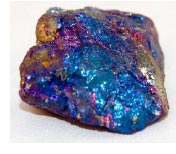by Cat Eye
From: The Pick and Dop Stick, 5/2013
1st Place — 2014 AFMS Junior Article (12 – 17)

When something is dirty, we usually clean it. We have car washes, dishwashers, and washing machines. We live in a world of dirt that has been made more sterile than ever before in history. However, some things are made prettier when they aren’t clean. The copper Statue of Liberty is now green from the tarnish building up over the years, and now it is famous for this green color and not its original brown color. Peacock ore is another example of a famously unclean specimen. It is a rock commonly found in the collections of beginning rock collectors and admired for its vibrant and metallic colors. Peacock ore is a pet name, referring to rocks made of the minerals bornite and chalcopyrite. The colors of peacock ore are actually tarnish upon the ore’s surface. There are many unique properties that define this beautifully dirty rock.
The official chemical formula of bornite is Cu5FeS4 and chalcopyrite is CuFeS2. The ore is very soft, with a hardness of three on the Moh’s hardness scale. This opaque rock has a beautiful metallic luster that is a result of the metallic elements within the ore. Peacock ore is very brittle and streaks a gray black color.
In addition to these basic characteristics, peacock ore has wide structural variety. These rocks can be found in isometric crystals, but only at extremely high temperatures. For peacock ore at temperatures lower than 228 degrees Celsius, or 442.4 degrees Fahrenheit, the ore is found in globular and unstructured formations. The structure can be a number of various formations, such as tetrahedral, octahedral, dodecahedral, or orthorhombic. The cleavage of peacock ore is very poor because the rock is more globular than crystalline in shape.
The most interesting aspect of peacock ore is its unique colorations. At first glance, peacock ore appears to be a rock made of metals that glimmer rainbow colors. However, this is only partly true. The process that causes peacock ore to have a variety of colors is similar to rust on a car. The paint on a car protects the metal structure underneath from the air. When the paint is scratched away and the metal is exposed, you will see rust form. This red-orange compound is created when the iron on the car and oxygen in the air react. Similarly, the colors of peacock ore are a result of what is called oxidation, an elemental reaction with oxygen. This tarnish forms on the outer surface where the copper in the rock comes in contact with the air. However, the oxides from peacock ore are stronger than rust, so the tarnish protects the rest of the rock from being oxidized. The oxidation occurs at an atomic level and the beautiful colors you see are actually only atoms thick. If you were to scratch the surface or break the rock, you would find that this rainbow rock is actually more of a red brown color. Although this is true, removing the tarnish or breaking the rock and exposing untarnished areas will start the oxidation process all over again, and a new layer of tarnish will form within a few hours.
The color of the tarnish is also fascinating. Over time, the tarnish actually turns black; however, the specimens we usually see are colored with greens, yellows, blues, and purples. The greens and yellows are from the oxidation of chalcopyrite, and the blues and purples are from the bornite. The oxidation of the copper in the minerals results in the creation of some copper oxide, which is Cu2O. This solid is black, but the fact that it is formed at an atomic thinness on the peacock ore allows for the beautiful colors. Colors are created when light bounces off objects. Light has a property called wavelength, which can be long and short. Certain wave lengths we cannot see, but the wavelengths we can see cause our eyes to register different colors. The various wave lengths proceed in the order of the rainbow with red as the longest and purple as the shortest. White light is actually a mixture of all the various wavelengths. As stated before, a person can see colors because of light bouncing off an object. As the light bounces, some of the light is absorbed, and the rest bounces off. Depending on the wavelengths bouncing off, the eyes see different colors. The thickness of the layer of tarnish in a certain area causes the variation in color. A thicker area absorbs more of the shorter wavelengths and causes a blue or purple color instead of a green or yellow. The thicker the layer gets in a certain area, the closer that area gets to being black, which is when the tarnish absorbs all visible wavelengths.
The world is so worried about dirt and germs that we live our lives trying to sterilize everything with our antibacterial soap and hand sanitizer and disinfectant aerosol cans. We have endless websites and discussions on how to best polish silverware or to remove tarnish from copper. However, those who study or simply enjoy rocks know better than to sterilize the world because there are so many treasures hiding in the dirt and the mud just waiting to be admired. As much as we love to be clean, we cannot be afraid of the dirt. Remember, don’t judge a book by its cover, but a pretty cover never hurts.
Sources:
1. Handbook of Mineralogy. Tucson: Mineral Data Publ., 1990. Print.
2. “THE MINERAL BORNITE.” BORNITE (Copper Iron Sulfide). Amethyst Galleries Inc. Web. http://www.galleries.com/Bornite.
3. “The Mineral Bornite.” Bornite Peacock Ore: The Mineral Bornite Information and Pictures. Hershel Friedman. Web. http://www.minerals.net/mineral/bornite.aspx.
4. “What Is Peacock’s Ore in Chemistry?” The Times Of India. Bennett, Coleman & Co. Ltd, 26 Jan. 2003. Web. http://articles.timesofindia.indiatimes.com/2003-01-26/open-space/27284724_1_colours-ore-chemistry.
For permission to reprint this article, contact us at info@chicagorocks.org.